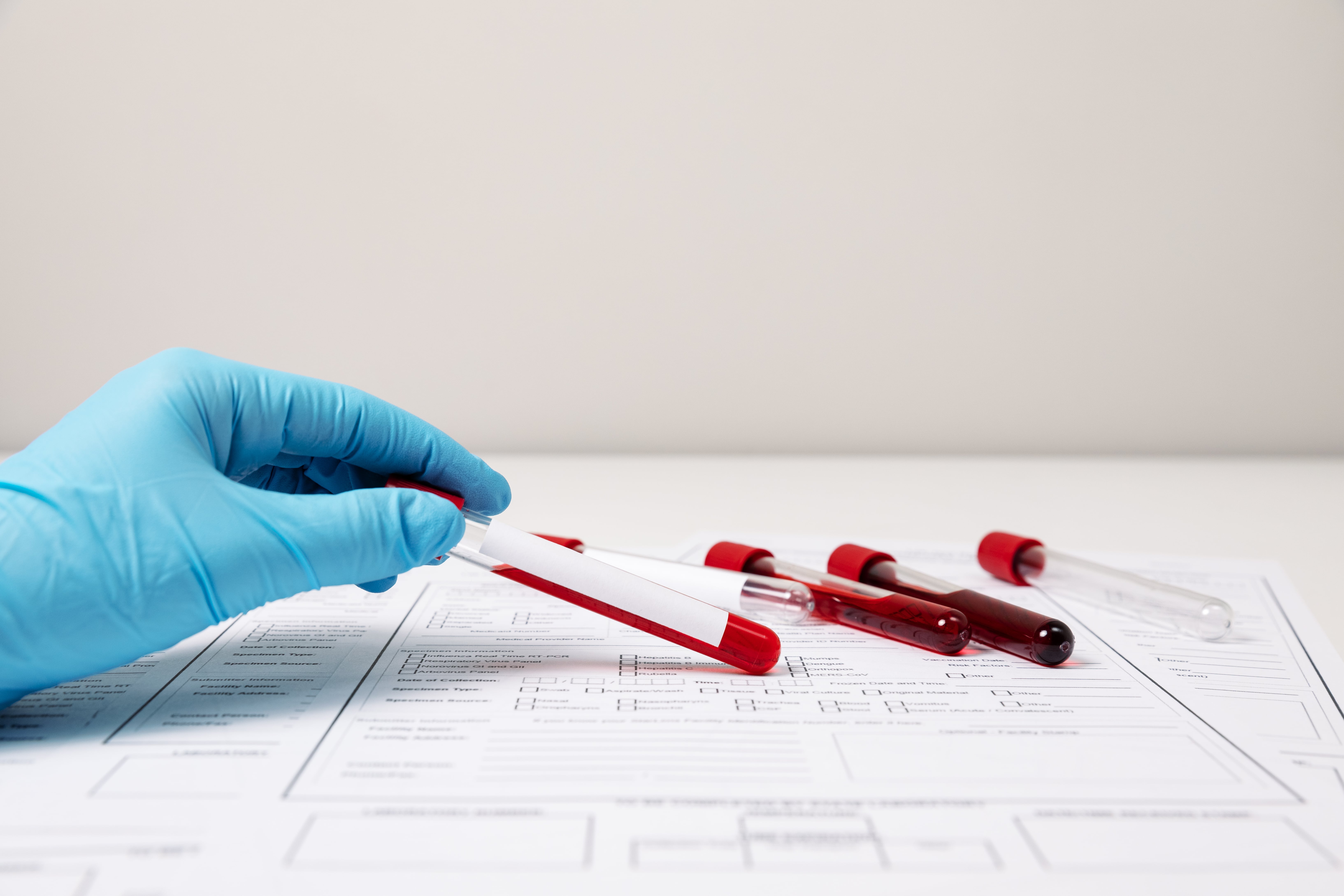Glucose variability is more than just a number; it’s a real-time reflection of how your body handles life’s daily challenges. From the food on your plate to the stress in your inbox, countless factors cause your blood sugar to rise and fall throughout the day. Mild shifts are normal, but frequent or dramatic swings can be a red flag, signaling higher risk for metabolic dysfunction and chronic disease.
Unlike average glucose metrics such as HbA1c, glucose variability captures the story between the readings, the spikes after meals, the dips after workouts, the fluctuations tied to stress or poor sleep. Thanks to a continuous glucose monitor (CGM), we can now see these patterns unfold in detail and take action sooner, making GV a powerful and often overlooked marker of metabolic health.
What Is Glucose Variability?

Your blood sugar naturally rises and falls throughout the day. These ups and downs are known as glucose variability, and while some fluctuation is completely normal, large swings (especially frequent spikes and crashes) can signal metabolic trouble. Typically, blood sugar levels increase after a meal and then slowly return to the basal glucose level or, in some cases, drop to low levels (hypoglycemia).¹
Glucose Spikes Are Normal, To A Point
After eating, it’s normal for glucose levels to rise. Your body digests the carbs in your food and converts them into glucose, which enters the bloodstream and provides energy. From there, insulin helps move glucose into your cells, and your levels gradually return to baseline.
But when those spikes are too high or followed by sharp crashes, like reactive hypoglycemia, it can leave you feeling drained, foggy, or hungry again too soon, and over time, contribute to insulin resistance.
People with prediabetes and diabetes tend to experience more pronounced glucose variability, but even those with “normal” labs can have significant spikes.¹
Why A1C Doesn’t Tell The Whole Story
The hemoglobin A1c (HbA1c) test is commonly used in clinical settings to assess long-term glucose control. It reflects your average blood sugar levels over the past 2 to 3 months.¹
While helpful, A1C has one major blind spot: it can’t show how often your blood sugar is spiking or crashing throughout the day. Two people could have the same A1C, but one might have smooth, steady glucose levels while the other experiences sharp peaks and dips.1
That’s where tracking glucose variability becomes essential.
How Signos Calculates and Displays Glucose Variability
In the Signos app, glucose variability (GV) is more than just a static metric; it’s a dynamic insight into how your body responds to your daily choices. We use a clinically accepted formula for GV: the coefficient of variation, calculated as the standard deviation divided by the mean glucose value, expressed as a percentage.
This approach is widely used in academic research and clinical settings to quantify glycemic fluctuations. But unlike many studies and devices that apply this calculation inconsistently, Signos takes it a step further.
Why Duration Matters and How Signos Accounts for It
Most research papers and glucose monitoring tools overlook a critical issue: GV increases with the length of the CGM data window. In other words, comparing a person’s GV over 6 hours vs. 48 hours will naturally yield different results, not because their glucose stability changed, but simply because the time window expanded.
At Signos, we normalize for this.
We adjust GV based on the duration of the CGM data, standardizing all variability scores to a 24-hour equivalent. This mathematical correction makes GV values directly comparable, whether you're tracking your own progress day to day, or looking across different timeframes, sensors, or users.
This adjustment gives you a more accurate, meaningful, and comparable picture of glucose stability, so you can better assess how your lifestyle, food, exercise, or stress management strategies are working over time.
How Glucose Swings Impact Your Energy Levels

If you’ve ever felt wired one minute and wiped out the next, your blood sugar may be to blame. People with high glucose variability, frequent sharp spikes and drops in glucose, often experience energy highs followed by crashes.
The Crash After the Spike
A glucose spike can sometimes feel like a temporary energy boost. But when blood sugar rises too quickly, the body may respond with a surge of insulin, which can drive glucose down just as fast. This leads to the dreaded “sugar crash,” often leaving you tired, foggy, shaky, or ravenous soon after eating.
Understanding Hypoglycemia
Low blood sugar, or hypoglycemia, is generally defined as a glucose level below 70 mg/dL (3.9 mmol/L). However, symptoms often don’t show up until levels drop below 55 mg/dL (3.1 mmol/L). Common causes include fasting, intense exercise, illness, or postprandial hypoglycemia, a dip in glucose that occurs a few hours after eating, especially after a high-carb meal.²
Signs Your Blood Sugar May Be Too Low
When glucose drops too far or too fast, your body sounds the alarm. Common symptoms include:3
- Fatigue or sudden tiredness
- Dizziness or lightheadedness
- Irritability or mood swings
- Jitteriness or shaking
- Intense hunger
- Rapid heartbeat
- Headache or brain fog
- Trouble concentrating
If you’re noticing these symptoms regularly, especially after meals, it could be a sign of unstable glucose patterns.
The Connection Between Glucose Swings and Mood
Your brain is highly sensitive to changes in blood sugar, and when glucose levels fluctuate too high or too low, your mood and mental state often follow.
The “Hangry” Effect Is Real
When blood sugar drops, it can trigger restlessness, nervousness, anger, and irritability, a state many describe as hangry.4 Hypoglycemia (low blood sugar) can also reduce alertness, slow reaction times, and impair memory and concentration.⁵ In short, your brain doesn’t function optimally when it’s running low on fuel.
On the flip side, high blood sugar (hyperglycemia) isn’t much better. Research shows that sudden spikes in glucose can lead to emotional lows, including sadness, anxiety, and difficulty focusing, particularly in people with insulin resistance or type 2 diabetes.6
How Glucose Swings Drive Cravings and Hunger

Cravings are complex, shaped by emotions, habits, hormones, and environment, but one major driver is blood sugar fluctuation.⁷
Cravings Intensify with Glucose Drops
When blood sugar drops rapidly, the brain perceives it as an energy emergency. It sends strong signals to eat, often pushing you toward a quick-fix, high-carb foods like bread, sweets, or processed snacks.8
In one study, 65% of people with type 1 diabetes mellitus experiencing low blood sugar reported intense food cravings, compared to just 15% when their levels were stable.8
Cravings during low-glucose moments aren’t just about willpower; they’re biological. Your body craves fast energy, even if it means another spike-and-crash cycle.
Low blood sugar levels trigger cravings, leading you to choose high-glycemic foods. The cycle continues with a spike and a glucose crash. This cycle makes it harder to stabilize energy, mood, and appetite. Over time, it can contribute to overeating and make metabolic regulation more difficult..
Breaking the Cycle
Stabilizing blood sugar is one of the most effective ways to reduce cravings and support a more balanced relationship with food. In fact, people with type 2 diabetes mellitus reported fewer food cravings when they followed a nutrition plan, stayed consistent with medical care, and developed more awareness around their eating patterns.9
Glucose stability isn’t just about metabolic health; it’s a foundation for better focus, fewer cravings, and a steadier emotional state.
Why Stable Glucose Matters for Mental and Physical Well-Being

Blood sugar doesn’t stay perfectly flat, nor should it. But keeping glucose within a healthy, steady range with minimal spikes and crashes can have a powerful impact on both your physical and mental well-being.
The Problem with Glucose Swings
Frequent blood sugar spikes and drops, known as high glucose variability, can negatively affect every organ in the body. Over time, it’s been linked to:1
- Insulin resistance and progression to type 2 diabetes
- Increased oxidative stress and inflammation
- Higher risk of both macrovascular complications (like heart disease and stroke)
- Microvascular complications (like diabetic eye issues, kidney, and nerve damage, especially in people living with diabetes
Even without diabetes, unregulated glucose can quietly contribute to long-term metabolic dysfunction.
Why Stability Matters
Maintaining steadier glucose levels can reduce your risk for chronic conditions and support better daily functioning. The benefits include:1
- Fewer food cravings: when your glucose is stable, your brain doesn’t send emergency signals to seek fast, high-sugar foods. This means fewer cravings and more control over your food choices.
- More stable mood and energy: fluctuations in blood sugar can trigger irritability, anxiety, and fatigue. Stable glucose helps support emotional steadiness and mental clarity.
- Lower risk of hypoglycemia: for people with diabetes, fewer drastic swings means lower risk of dangerous lows, which can be life-threatening if unmanaged.
Small Shifts, Big Impact
Glucose stability isn’t just a clinical metric; it’s something you can feel. More energy, fewer cravings, better focus, and improved long-term health all start with understanding and responding to your body’s glucose patterns.
6 Practical Strategies to Lower Glucose Variability

Keeping your glucose steady doesn’t require perfection, just consistency and a few smart strategies. Here’s how to reduce swings and support a more stable metabolism.
Build balanced meals with fiber, protein, and healthy fats
Meals that include lean protein, healthy fats, and fiber help slow digestion, leading to a more gradual rise in blood sugar. This approach not only reduces post-meal spikes but also promotes satiety, steadier energy, and fewer cravings.10 A personalized nutrition plan is a cornerstone of managing diabetes, but it’s just as beneficial for anyone looking to stabilize glucose and improve metabolic health.
Be strategic with high glycemic index foods
Foods with a high glycemic index can cause quick blood sugar spikes followed by sharp drops, especially when eaten alone. To soften the impact, choose lower-glycemic alternatives when possible (like steel-cut oats instead of instant oats). Also, pair high-GI foods with protein, fat, or fiber to slow glucose absorption and blunt the spike.10 It’s not about cutting out carbs; it’s about creating balance.
Cut back on between-meal carb snacking
Frequent carb- or sugar-heavy snacks keep your glucose on a roller coaster, making it harder for your body to return to baseline between meals. Aim to space meals 3–4 hours apart, allowing your glucose to stabilize before eating again. If you need a snack, opt for one rich in protein or healthy fats, or consider foods with resistant starch (like cooled potatoes, green bananas, or overnight oats), which studies show cause a smaller glucose rise when eaten later compared to when they’re freshly cooked.10 Fewer spikes between meals can lower your overall glucose variability and make it easier to maintain steady energy.
Move your body regularly
Physical activity helps your body use glucose more effectively and improves insulin sensitivity. It also reduces overall glucose variability, even in people without diabetes. Aim for a mix of aerobic activity (walking, cycling, swimming, dancing) and resistance training (weights, bodyweight exercise, resistance bands).11,12 Even short walks after meals can make a noticeable difference in post-meal glucose curves.
Manage daily stress
Tracking your glucose with a CGM or glucose meter gives you insight into how your body responds to food, activity, stress, and sleep. Watching your patterns helps you spot what’s working and where there’s room to adjust. If you’re seeing large swings or frequent highs and lows, bring that data to your healthcare provider. It can help fine-tune your care plan or inform more personalized treatment.
Talk to your doctor about medication options
Some medications are more effective at reducing glucose variability. If you’re on medication and still experiencing large swings, it may be worth asking your healthcare provider if there are alternatives better suited to your needs.10
Stabilizing glucose doesn’t happen all at once, but small, consistent changes can add up to real results. In-the-moment tracking helps you stay informed, make better decisions, and feel more in control of your health.
When to Consult a Healthcare Provider

Your body gives you signals when something’s off, and your glucose data can help you make sense of them. If you're experiencing frequent glucose swings or symptoms that affect your quality of life, it may be time to check in with your healthcare provider.
Key Signs to Watch For
- Symptoms of hyperglycemia (high blood sugar), like fatigue, frequent urination, increased thirst, or blurred vision
- Symptoms of hypoglycemia (low blood sugar), including shakiness, dizziness, irritability, or sudden fatigue
- Mood swings, brain fog, or energy crashes, especially after eating
- Intense or frequent food cravings that feel hard to manage
- Known diabetes or prediabetes, with ongoing blood sugar fluctuations
High glucose variability may indicate poor glycemic control, and over time, it’s linked to increased risk of complications, especially in people living with diabetes. These include cardiovascular issues, nerve damage, and kidney problems.
The Bottom Line
Glucose variability refers to fluctuations in blood glucose levels throughout the day. However, when these glucose fluctuations become extreme (either too high or too low)and occur too frequently, they lead to high glucose variability. This can contribute to mood swings, decreased quality of life, and complications of diabetes. You can support stable blood glucose by eating well-balanced meals, exercising, managing stress, and monitoring blood sugar levels.
Learn More With Signos’ Expert Advice
With Signos, you can monitor changes in your glucose profile. A continuous glucose monitor (CGM) can provide valuable insights into how your diet and lifestyle affect glucose variability. If you think this article was useful, learn more about glucose levels on the Signos blog.
Topics discussed in this article:
References
- Suh, S., & Kim, J. H. (2015). Glycemic variability: how do we measure it and why is it important?. Diabetes & metabolism journal, 39(4), 273. es & Metabolism Journal 2015;39(4):273-282. Doi: https://doi.org/10.4093/dmj.2015.39.4.273
- Ahmed, F. W., Majeed, M. S., & Kirresh, O. (2023). Non-diabetic hypoglycemia. In StatPearls [internet]. StatPearls Publishing. Retrieved July 29, 2025 from:https://www.ncbi.nlm.nih.gov/books/NBK573079/
- Low Blood Glucose (Hypoglycemia). The National Institute of Diabetes and Digestive and Kidney Diseases. Retrieved July 29, 2025 from:https://www.niddk.nih.gov/health-information/diabetes/overview/preventing-problems/low-blood-glucose-hypoglycemia#symptoms-lbg
- Swami, V., Hochstöger, S., Kargl, E., & Stieger, S. (2022). Hangry in the field: An experience sampling study on the impact of hunger on anger, irritability, and affect. Plos one, 17(7), e0269629. Doi:https://doi.org/10.1371/journal.pone.0269629
- Verhulst, C. E., Fabricius, T. W., Nefs, G., Kessels, R. P., Pouwer, F., Teerenstra, S., ... & de Galan, B. E. (2022). Consistent effects of hypoglycemia on cognitive function in people with or without diabetes. Diabetes Care, 45(9), 2103-2110. Doi:https://doi.org/10.2337/dc21-2502
- Cox, D. J., McCall, A., Kovatchev, B., Sarwat, S., Ilag, L. L., & Tan, M. H. (2007). Effects of blood glucose rate of changes on perceived mood and cognitive symptoms in insulin-treated type 2 diabetes. Diabetes Care, 30(8), 2001-2002. Doi:https://doi.org/10.2337/dc06-2480
- Oliveira, J. D. (2022). The body asks and the mind judges: the episode of food craving, its triggers and nutritional treatment. einstein (São Paulo), 20, eMD6705. Doi:https://doi.org/10.31744/einstein_journal/2022MD6705
- Strachan, M. W., Ewing, F. M., Frier, B. M., Harper, A., & Deary, I. J. (2004). Food cravings during acute hypoglycaemia in adults with Type 1 diabetes. Physiology & behavior, 80(5), 675-682. Doi:https://doi.org/10.1016/j.physbeh.2003.12.003
- Çavuşoğlu, E., Çayir, Y., & Gün, M. (2025). Investigation of food cravings in individuals with type 2 diabetes: A hierarchical regression analysis. Primary Care Diabetes, 19(2), 173-177. Doi:https://doi.org/10.1016/j.pcd.2025.01.009
- Zhou, Z., Sun, B., Huang, S., Zhu, C., & Bian, M. (2020). Glycemic variability: adverse clinical outcomes and how to improve it?. Cardiovascular diabetology, 19(1), 102. Doi:https://doi.org/10.1186/s12933-020-01085-6
- Zhu, X., Zhao, L., Chen, J., Lin, C., Lv, F., Hu, S., ... & Ji, L. (2021). The effect of physical activity on glycemic variability in patients with diabetes: a systematic review and meta-analysis of randomized controlled trials. Frontiers in endocrinology, 12, 767152. Doi:https://doi.org/10.3389/fendo.2021.767152
- Figueira, F. R., Umpierre, D., Bock, P. M., Waclawovsky, G., Guerra, A. P., Donelli, A., ... & Schaan, B. D. (2019). Effect of exercise on glucose variability in healthy subjects: randomized crossover trial. Biology of Sport, 36(2), 141-148. Doi:https://doi.org/10.5114/biolsport.2019.83006
- Velasco, J. M., Botella-Serrano, M., Sánchez-Sánchez, A., Aramendi, A., Martínez, R., Maqueda, E., ... & Hidalgo, J. I. (2022). Evaluating the influence of mood and stress on glycemic variability in people with T1DM using glucose monitoring sensors and pools. Diabetology, 3(2), 268-275. Doi:https://doi.org/10.3390/diabetology3020018




.svg)










.svg)
.svg)
.svg)
.svg)
.svg)
.svg)
.svg)
